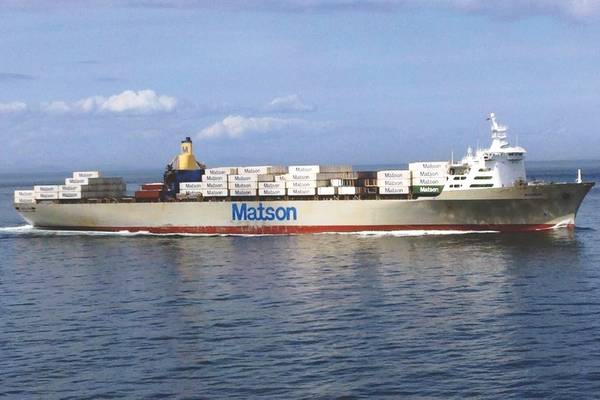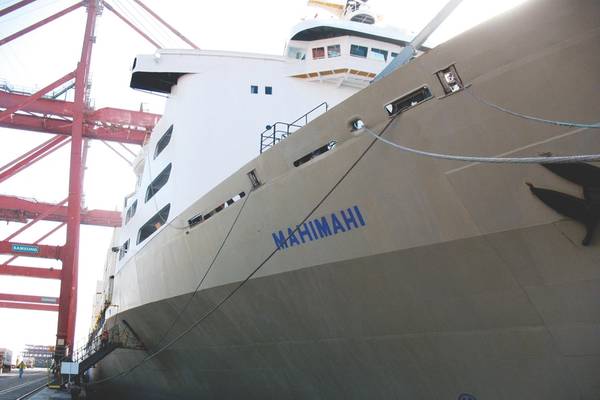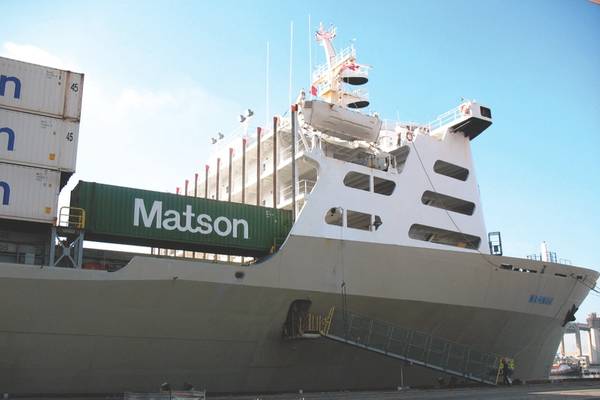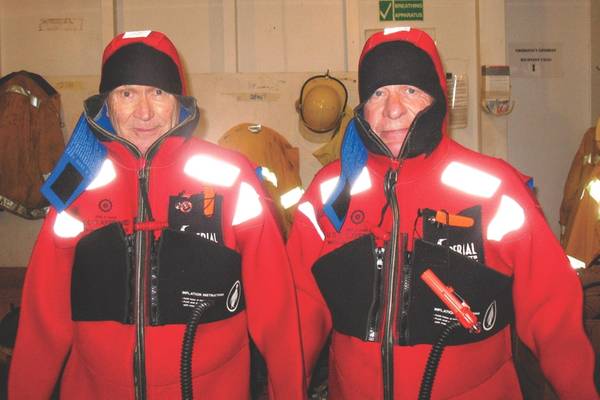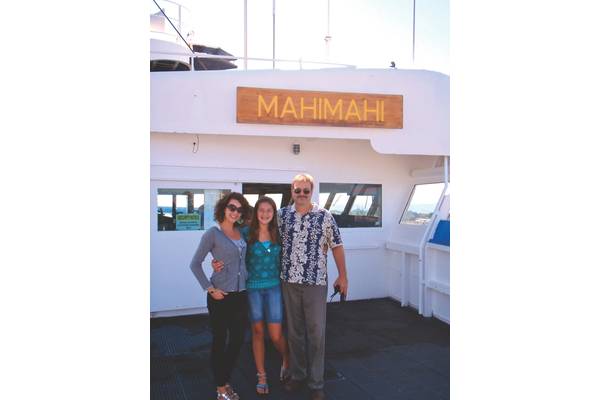From a boy who wanted to be a swashbuckler like Errol Flynn to a Maine Maritime graduate to hopping aboard a grain ship bound for Egypt, Captain Theodore “Ted” Bernhard has led a quintessential maritime life. A ship driver with 37 years of maritime experience, Bernhard has spent half of his adult life at sea, the last 20 years on containerships with Matson, the ubiquitous U.S. commercial maritime presence in the Pacific Ocean. Life at sea in 1979 – with no cell phones, no internet and no email – was fairly different than it is today, but was it better? Was it worse? To find out, Maritime Logistics Professional spent an afternoon with Captain Bernhard to discuss the ever-evolving life of a U.S. Jones Act fleet mariner.
Graduating Maine Maritime in 1979 with a degree in Nautical Science and a minor in Ocean Engineering, Ted Bernhard was similar to most 22 year olds: in need of direction. “When I graduated I was at a crossroads; originally I was planning to join the Coast Guard,” said Bernhard. “But then, Ken Biebel, my college roommate and best friend to this day, called me and we ended up going on a grain ship to Egypt. I joined the union, took that grain ship to Egypt and I have stayed with maritime ever since.”
While every mariner’s career story is unique, the trajectory of Bernhard’s path is perhaps familiar to that of many of his contemporaries: the ‘70s to the ‘90s were more youthful and carefree, while the mid-90s to today are more structured and time-conscious. Father Time is not the sole culprit in this transformation, as the maritime industry itself, driven by consolidation and corporatization, driven by increased levels of regulation and legal liability, driven by technology that has seen the ship become a 24/7/365 monitored piece of an overall logistics puzzle, have changed the industry to its core.
“It was tough shipping in those first 10 years because it was a story of too few ships and too few jobs,” said Bernhard. “But it was also a free style of living; I was single, I was traveling the world and I was living in different countries.” By late 1980s, though, he tired of sailing as a junior officer, and was presented some opportunities that served as a launching pad for his career. But things started to change when his APL ship was bought by Matson. “That turned my whole life around,” said Bernhard.
The Matson Way
Founded in 1882, Matson is a familiar maritime company, the leading U.S. carrier in the Pacific providing a lifeline to the economies of Hawaii, Alaska, Guam, Micronesia and select South Pacific islands. Its fleet of ships includes containerships, combination container and roll-on/roll-off (ConRo) ships and custom-designed barges. Matson Logistics was established in 1987 and extends the geographic reach of Matson’s transportation network throughout the continental U.S.
“It always had that family feel to it. I love it,” said Bernhard. “It is still the best of the companies out there, and everybody knows it: we have good contracts, we have good relationships with the unions; and in general, it is the best run, the best thought of company with some pretty cool shipping runs.”
While The Jones Act is a perpetual political football (and not the focus of this feature), for mariners like Bernhard it has proved an essential ingredient to a healthy career. “The Jones Act is not even leveling the field, it simply makes it possible to go back and forth between our own states so that a foreign operator simply can’t come along and muscle us out, undercutting on price, safety and security,” he said. “When I graduated from school there might have been 1,000 total ships, including MSC; now there are just more than 100.”
Matson has been a steady hand in the U.S. maritime puzzle for generations, most recently announcing a $511 million order to buy a pair of new ships from General Dynamics NASSCO, a wholly owned subsidiary of General Dynamics (NYSE: GD), to build two new ConRo vessels for its Hawaii fleet at a contract price of $511 million for both vessels with deliveries scheduled for the end of 2019 and mid-year 2020.
The new Kanaloa Class honors the ocean deity revered in the native Hawaiian culture and the company will name each of the new vessels after predecessor ships from its 134-year history. The first vessel will be named Lurline, the sixth Matson vessel to carry that name, while the second vessel will be its fifth named Matsonia. The Kanaloa Class vessels will be built on a 3,500 TEU vessel platform, measuring 265 x 34.9m, with a deep draft of 11.5m and enclosed garage space for up to 800 vehicles. Central to the Matson way, the new vessels will have green technology features: a fuel efficient hull design; environmentally safe double hull fuel tanks; a fresh water ballast systems; and dual-fuel engines, able to operate up to 23 knots on either conventional fuel or LNG (with adaptation).
According to the company, the larger capacity of the Aloha Class and Kanaloa Class vessels will allow Matson to return to a nine-ship fleet deployment in Hawaii, increasing efficiency and lowering operating costs.
A Life at Sea: Operations
“We’re definitely seeing a lack of new people coming into the industry,” said Bernhard. “Even though they graduated from the academies, you don’t see them coming through the unions, you don’t see them going out to sea. They are finding jobs that are in parallel with the seagoing industry, something that very few people thought about (when he came out).”
Captain Ted Bernhard is a Master Mariner, sailing with Matson for 20 years, three years as chief mate and 17 as master. In addition he has spent more than 30 years in the Naval Reserve, and taught ship handling at the Naval War College in Newport, R.I., during the last 12 years of his reserve service. He sees a looming gap in maritime talent coming to the fore, as the push button/joystick generation is perhaps not as interested or adept in dealing with the ups and downs of a life at sea. He views new technology as a mixed blessing: new technology has had a tremendous effect on making shipboard operations easier in some regards, but it has come with an erosion of basic seamanship skills, a sentiment that is increasingly common in maritime circles.
“The young people that do want to come out to sea are technically capable,” said Bernhard. “They are not technophobes, but on the other hand I find that they trust technology too much. So you get people that are technologically advanced and superior to my generation, but they are also technologically handicapped in a way.”
“If someone pulls the plug on all of this stuff, how are we going to get from Oakland to Honolulu? Are we just going to hope we get there? What happens if all the electronic aids fail? Do you even know how to adapt and resume your voyage with centuries old navigation skills? Do you know how to take an azimuth, sun line, & stars? Do you even have paper charts and the nautical tables to work out the solutions?” Bernhard asks rhetorically. “Somebody’s going to pull the plug some day. It could be a terrorist act, it could be a military operation; it could be blanking someone out in a time of need. When that happens, what are you going to do; just throw your arms up in the air and say ‘we’re lost?’ Personally, I want to get home.”
Of course the ultimate application of advanced technology bandied about in technical conferences is in regards to unmanned ships, with several field tests underway and predictions that unmanned commercial vessel operations could start on certain point-to-point routes in as little as five years. The notion of unmanned ships fits more broadly into the commoditization of logistics operations globally, as land-based entities test the prospects of delivery via drone, and engineers at Google and Uber, among others, test the notion of driverless cars. When it comes to autonomy on the waterfront, Bernhard is succinct: “I say go for it if you think you can prove it. But inevitably something will go wrong, and it’s going to be catastrophic. You’re always going to need some people on board. There might be a trend toward a homogenous fleet and homogenous operations, but every captain and ship will continue to have its own style.”
A Life at Sea: Amenities
Advances in technology are certainly not limited to maritime operations, as crew amenities continues to be a prominent topic from management to seafarers alike. The previous generation’s life at sea was essentially unplugged from routine communications for weeks at a time, and many of the colorful anecdotes told today were in fact oftentimes difficult.
“I remember phone calls during the first Gulf war (in the early 1990s) where you would get off the ship in Fujirah and there would be one phone booth on the dock with a line of 40 sailors long waiting to use it. It was 120 degrees and mosquitoes everywhere. Then you’d get to the phone booth, you’d make your call and there’d be nobody home, so you’d get bumped to the end of the line,” Bernhard remembers. “You lived for that phone call, and that was it for the next three weeks. Well, that has all changed today. If you need to, you can make a call at any time.”
Bernhard in fact says that communications from ship to shore is likely the single biggest change in seafaring life today, as with phone calls, email and internet, constant connection is available, and indeed necessary in order to attract and retain the younger generation to a life at sea. But similar to the technology driving marine operations, the advantages of enhanced amenities at sea is not always black and white.
“On my old ships we had a library and a lounge with a dozen books that the seafarer’s institute would donate, and maybe a few magazines from 20 years ago. If you were lucky that was your ‘library’. For big events like the Super Bowl we had ‘Voice of America’ and ‘Radio Moscow’ to listen in. That has all changed tremendously,” said Bernhard. “Today we have a full library that we made ourselves; I have a full gym, we have a media and movie room; we have email that we run daily, we get satellite TV and satellite radio on the coasts.”
But while the comfort level on board has improved dramatically, Bernhard senses a loss of camaraderie along the away. “It used to be four guys in a room, now it’s everyone in their own room, with their own head. We used to have one message a month from the office. Now you’re getting 100 emails a day. It’s great to have satellite TV, but if the TV goes out the guys complain because they don’t have 2,000 movies at their fingertips. That’s the kind of rumblings you start to hear.”
Gone too are the freedom of port calls, of spending days, weeks and maybe even a month in port, particularly in the container shipping sector where calls are measured in hours, not days. “With Matson we usually still get an overnight, which is pretty good for a container company, but it’s gotten so squeezed (time-wise) that there is not much of a life outside of the ship. In some ways that’s a good thing, because while some of the stories sound interesting in retrospect, they were painful during the process.”
“I love my job; but some of the fun part is getting squeezed out by legal regulations and oversight that is immediate and swiftly dealt,” said Bernhard. “There’s not as many of the traditional swashbuckling stories left out there, or just different types of adventures. You have to be ‘Cool Hand Luke’ with everything, but then look what happened to Luke in the end.”

